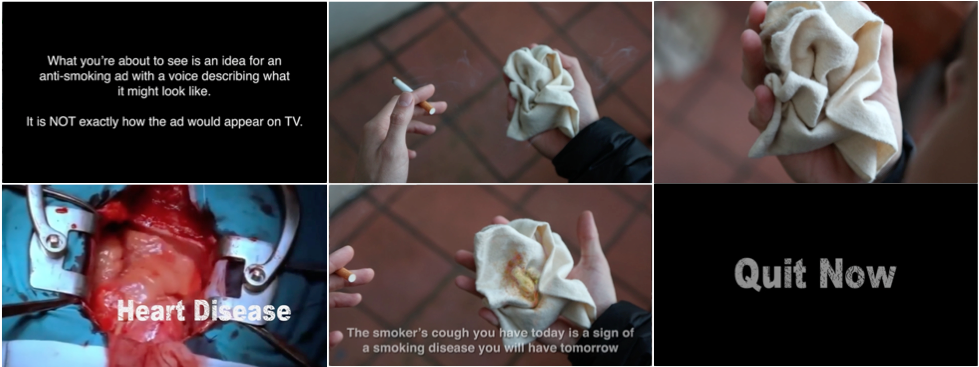Communication is a key component of public health and of Vital Strategies’ work. Our organization works to advance the practice of communication and to build the ability of our partners—mostly governments in low- and middle-income countries—to implement strategic communication interventions that shape public support for better health policies and address health behaviors at the population level.
In 2016, we undertook an effort to create a new set of mass media campaign options to offer countries. The goal was to expand our resource library (Media Beacon) with three effective, highly adaptable smoking cessation PSAs that would have the potential to work with audiences around the globe. We needed these PSAs to be gripping—to get through to smokers, and motivate them to consider quitting. We wanted to offer new messages that couldn’t be ignored, that would create a sense of urgency to quit now. Moreover, the creative approach had to feel relevant to people in diverse settings and cultures.

The two most expensive components of an effective campaign are message and creative development, and media buying. Time and again we see the same issues: countries either invest so much in creating material that they don’t have sufficient resources for a media buy; or they don’t invest enough in developing good materials, and their large media planning investment is wasted on ineffective messaging.
To address this, over the years we have worked with partners to adapt successful ads from other countries. This saves tens of thousands of dollars, or more, that can instead be put towards media placement. Starting with successful campaigns from other countries, many of which have had impact with multiple diverse audiences, also gives Ministries of Health a high level of confidence that the materials will be effective.
We’ve seen great success with these adapted campaigns. Unfortunately, there is a limited assortment of campaign materials that are both effective and easy to adapt. This shortage is what brought us to the current project.
Not only did we want to offer fresh new PSAs for adaptation – we wanted to provide an entire set of media materials to support campaigns where resources are spare: radio, print, digital, billboards. Essentially, we wanted to come up with three distinct campaigns “in a box” that could remove a barrier for tobacco control advocates in countries with many smokers but few resources.
Guided by global best practice in mass media campaigns, we undertook a lengthy and meticulous process to develop and produce three excellent smoking cessation PSAs and campaign resource kits. We knew this would require the expertise of our own team as well as message testing with diverse audiences and a skilled creative and production partner.
We sourced our senior advisory team for their input on the greatest gaps in health harms messaging for smoking cessation. For example, many people understand that smoking causes lung cancer – but fewer know about the risk of stroke, heart disease, and other cancers throughout the body.
We requested proposals from agencies on four continents – teams with track records for creating award-winning public health material. We challenged them each to come up with several plans for campaigns that would have strong enough creative concepts to get through to smokers and be effective across the diverse contexts in which we work.
A thorough internal selection process led our team to engage Behaviour Change Partners, an Australia-based agency with decades of experience in tobacco control and an understanding of communication for behavior change – not just for advertising – they gave us confidence that we had found a good partner.
After months of brainstorming, discussion, and an iterative process in which Behaviour Change Partners pitched different creative concepts based on our team’s feedback and guidance, we landed on six concepts for testing. We used a research agency to conduct message testing through focus group discussions with participants unique to our typical target audiences.

Using animated storyboards matched with audio in small group settings, we collected quantitative and qualitative data to evaluate the concepts. We compared them based on the audience’s understanding, reactions, and opinions on whether the ads would be effective in getting smokers to quit. Analysis of our data showed three clear winners that would go on to production: Coughing up Disease, What Damage Will This Cigarette Do?, and Living with Smoking.
All three of our new adaptable PSAs and accompanying campaign material take on the physical perspective of the smoker, prompting the viewer to place him or herself in the smoker’s shoes. The first two PSAs focus on two things any regular smoker can identify with: reaching down to pull out a cigarette from a pack, and the infamous smoker’s cough. We wanted to take these two routine (and perhaps banal) elements in the life of a smoker and associate them with the real harms that come with smoking: Each and every cigarette adds to your risk. Your cough is a sign your body is being damaged – and not just your lungs.
The third video focuses on one of the lesser-known but often tragic health risks related to smoking: stroke. Scenes in the ad take the viewer through a day in the life of a man who has suffered a severe stroke and whose family must assist him in all daily tasks. As he explains, his smoking gave him a stroke, but it is his family that is suffering most.
Producers had to get quite creative in filming all three of these videos, to get the correct distances and angles to simulate the gaze of the smoker himself. Careful thought was given to all shots, wardrobe and set design, to help ensure that the videos could be easily adapted around the world. Two of the videos were shot twice, with actors of different ethnicities, to ensure adaptability for wider audiences.

Now Vital Strategies can now offer three new complete sets of adaptable campaign materials to countries ready to reduce smoking and save lives. An adaptation has already been produced and aired in Indonesia to a great response on traditional and social media. This is the first of we hope many adaptations of these campaigns. For more information and to view the videos, please visit them on our newly redeveloped media resource library, Media Beacon.
For inquiries or requests to use this material in tobacco control programs, please contact info@vitalstrategies.org.